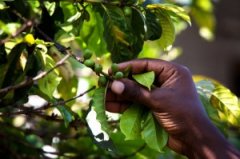Chinese boutique coffee Taiwan Gukeng coffee beans
Taiwan Gukeng Coffee

Taiwan Gukeng Coffee originated in Huashan area, Gukeng Township, Yunlin County, Taiwan. At a time when the ancient pit on the Tropic of Cancer is full of sunshine and rainfall, the Taiwan native coffee produced is sweet, fragrant and not bitter, and has its own local flavor. It belongs to the best coffee in the world. Because it was accidentally found that Gukeng is quite suitable for growing coffee regardless of climate, soil or drainage, Gukeng Township has become one of the few places in Taiwan where high-end coffee can be produced. Gukeng coffee belongs to Arabica, because the method and time of baking and extraction are different from other rich coffee producing areas. Gukeng coffee has a special flavor and is known as the "hometown of Taiwan coffee."
It is said that during the Guang Xu years of the Qing Dynasty, when British businessmen came to Taiwan, they accidentally found that Taiwan's climate, soil and other natural environment were very suitable for growing coffee, especially because the Gukeng Township of Yunlin County near the Tropic of Cancer was similar to the top coffee in Brazil. The locally produced coffee is rich in aroma, not bitter and astringent, with a smooth entrance and a sweet aftertaste, with a unique local flavor of Taiwan.
According to the Chronicles of Yunlin County, Gukeng coffee was introduced during the Japanese occupation. After the Government House of Taiwan introduced coffee beans from Brazil, it selected Taitung, Mizuho, Kaohsiung, Yunlin Gukeng and Nantou Huisun Forest Farm as trial cropland, and finally found that Yunlin Gukeng was of the best quality and became a tribute to the Japanese emperor during the Japanese occupation period. Gukeng coffee has the nickname "Imperial Coffee". Also participated in the "Arabica Coffee" competition, won the second place in the world, famous at that time, the aroma of sweet coffee has spread to this day.
History of Gukeng Coffee in Taiwan
Coffee was introduced by the Dutch in the early days of 1624, but it was not widely promoted because it was limited to internal drinking among the Dutch.
In 1931 (Rizhaohe 6 years), Mr. Kimura planted and cultivated in large quantities in the area of Chiayi and Yunlin Gukeng in northern Tainan.
In 1941 (the 16th year of Rizhaohe), most of the raw beans were shipped back to Japan. The coffee planting area of Hebao Mountain in Huashan area of Gukeng Township is as wide as 75 hectares, and it is known as "the largest coffee factory in the far East" in its heyday.
In 1945 (Rizhaohe 20 years), the area of coffee cultivation in Huashan area expanded to 113 hectares after the war. However, as the price of the cash crop fell, most of the coffee fields were abandoned or transferred for other uses.
In 2000 (1989), it was not until it was publicized by the Taiwan government that local farmers returned to widespread production and marketing.
In 2003 (1992), the Yunlin County government held the first Taiwan Coffee Festival in Jianhu Mountain Amusement area and invited Mr. Huang Gengzi to attend.
In 2006 (1995), the planting area of coffee in Gukeng Huashan area was about 100ha, with an output of more than 10000 kg.
Because of its low output and good reputation, there are a considerable number of other brands of coffee outside Taiwan posing as Gukeng Coffee. For this reason, Gukeng developers intend to use "23.5" as the brand name as the symbol of the original Gukeng coffee. On the other hand, the 23.5 is taken from the position of 23.5 degrees north latitude of Gukeng.
Growth of Coffee in Gukeng, Taiwan
The latitude of Gukeng is located at 23.5 degrees, with an altitude of 600 to 1500 meters, and the annual rainfall is between 1500 and 2000. Every afternoon, there is a fixed rain that "quickly comes and goes", so that the coffee tree can absorb enough water, and the soil is gravel with good drainage. It will not absorb too much water. Huashan moves east and west, the sun shines half a day, and there is shade to shade the sun. various conditions enable coffee trees to grow up in peace of mind here. From about the 1890s, Gukeng was found to have unique conditions and began to grow coffee, concentrated in Huashan, South China, Guilin, purse and other areas. He was honored as the runner-up in the world coffee competition. Later, due to the transformation of agriculture and the lack of popularity in drinking coffee, the "hometown of coffee" was transferred to other crops. In recent years, this proud secret was rediscovered, and the once-interrupted coffee culture was revived again. The coffee tree in the ancient pit is Arabica, which is the same as the blue mountain, Manning and other well-known coffee beans, and grows at a higher altitude. Coffee berries take a long time to breed, hard texture, rich aroma, and mellow taste. After manual pruning, the coffee tree is about two meters high. it can start mass production in the fourth year after planting, and it will be "retired" for 25 years. It begins to blossom around April every year, then bears fruit one after another, and can be harvested when the fruit turns cherry red in October. The coffee fruit is a drupe with a berry-shaped pulp between the peel and the beans and is surprisingly sweet when ripe. The harvested coffee fruit must first go through the sun, remove the water, and then peel, soak, ferment and dry (called water-washed beans), and then take off the inner shell and enter the baking. The ancient way to stir-fry beans is to use a charcoal fire to enlarge the pot, and someone has to keep stirring with a big shovel, because the temperature is not high enough and it will take four hours to complete. Now the coffee garden is baked by machine, taking into account the taste of Chinese people, shallow roasting at a high temperature of 200 degrees for about 20 minutes. But you still have to be there in the process, sampling from time to time, and you have to hear the beans from the sound of "bursting". After the fried beans are cooled, they have to be placed for another three days to blend thoroughly with moisture and air, so that the flavor can reach its best.
Taiwan's Gukeng coffee beans are scarce and do not meet the demand of the Taiwan market.
Important Notice :
前街咖啡 FrontStreet Coffee has moved to new addredd:
FrontStreet Coffee Address: 315,Donghua East Road,GuangZhou
Tel:020 38364473
- Prev

Guatemala Antigua Fine Coffee Coffee beans
La Flor del is the star product of La Minita Manor. La Flor del literally means "Coffee Flower". It comes from the high altitude in the center of the volcanic area of Antigua, has unique volcanic soil and shade planting, and lays a good foundation for excellent quality.
- Next

Asia Indonesia Best Gift Boutique Civet Coffee Bean
Civet coffee Civet coffee, the most expensive coffee bean. The game of cat and mouse in coffee beans was the first to make a name for itself in Indonesia. Vietnam also had weasel coffee. Taiwan also made civet coffee. Of course, the Philippines, which is similar to Indonesia, can make musk cat dung coffee. Kopi Luwak, Kopi(Indonesian, coffee), Luwak is Indonesian
Related
- Guji coffee producing area of Guji, Ethiopia: Humbela, Shakiso, Wulaga
- What is the most expensive variety of Qiloso in BOP multi-variety group?
- How to store the coffee beans bought home?
- Why are Yemeni coffee beans so rare now?
- Ethiopian Sidamo all Red Fruit Sun Sun Santa Vini Coffee beans
- SOE is mostly sour? What does it mean? Is it a single bean? what's the difference between it and Italian blending?
- Is Italian coffee beans suitable for making hand-brewed coffee?
- How to choose coffee beans when making cold coffee? What kind of coffee beans are suitable for making cold coffee?
- Just entered the pit to make coffee, what kind of coffee beans should be chosen?
- Can only Japan buy real Blue Mountain Coffee? What are authentic Jamaican Blue Mountain coffee beans?

